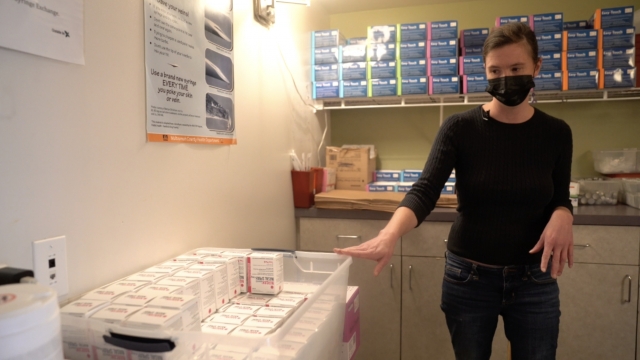In the back of the Outside In office are cabinets filled with boxes of supplies. They're what's called "safer-use supplies," which include syringes, wound care, mixing cups and drug pipes.
To Haven Wheelock, each box of supplies at the Portland medical and youth service nonprofit has a purpose: To prevent people from dying.
"Things like smoking supplies are a really important tool for overdose prevention," Wheelock said. "You're not gonna get HIV, Hepatitis C, smoking drugs. It also allows for people to use more slowly."
Wheelock runs the Drug Users Health Services program at Outside In, which provides these supplies each day to around 100 people coming in off the street.
"We are one of the oldest harm reduction programs actually in the country, so we've been providing syringe access and other harm reduction tools since 1989," she said.
Harm reduction refers to the actions and policies meant to lessen consequences associated with drugs. It's one strategy the Biden administration has helped fund to help communities battle the opioid epidemic.
SEE MORE: Drug harm reduction programs could help weaken the fentanyl crisis
These programs started during the AIDS epidemic in the '80s, when clean syringes were given away in hopes of stopping the spread of the virus. A movement spearheaded by drug users, it became an accepted practice by municipalities and health care workers because it proved effective.
Though the supplies are important, at the core, Wheelock says the mission is to build relationships with people who come in, being there for them when and if they are finally ready to accept treatment and then setting them up with resources.
"People aren't gonna change behaviors if they don't feel like they're worthy of that change or if they don't have the tools to make change," she said.
Dr. Bradley Buchheit is an addiction medicine physician at Oregon Health and Science University. He works at its HRBR Clinic, which stands for Harm Reduction and Bridges to Care Clinic.
"We're meant to sort of capture people when they're ready and interested in treatment, stabilize them and then work with them to find a long-term prescriber or treatment opportunity in their local community," he said.
When someone addicted to opioids or methamphetamines tells Wheelock they're ready for treatment, they're put in touch with the clinic, which helps to get them medical addiction treatment, like Suboxone or methadone.
"The harm reduction that we practice in HRBR really is low barrier, on-demand access to FDA-approved medications for opioid use disorder," Buchheit said.
The harm-reduction-to-treatment pipeline the organizations have created is important, Buchheit says, because it puts the least amount of time between the user's change of heart and treatment — something he believes needs to happen more across the country.
SEE MORE: This 'harm reduction machine' aims to combat the drug epidemic
"Until those treatment services are easier to access than street drugs, it's gonna be really hard for us to get ourselves out of the current crisis that we're in," he said.
These types of harm reduction programs are highly criticized. There are people in homeless and addiction advocacy, plus some outside of the work, who believe Wheelock's work is enabling drug use or that addiction treatment clinics like Buchheit's are just replacing one drug with another.
It's an argument Wheelock has faced for as long as she has done this work.
"I push back on this idea that enabling people is bad. I want to enable people to be as healthy as possible," she said. "Are we making drug use easier in the lives of people who use drugs? Yeah, we are because making it harder is harming people. It is not like punishing people who are already hurting. If that was gonna work, it would've worked already."
Harm reduction, to the people in the work, is a chain reaction that shows empathy and builds trust; trust can lead to healthier decisions, and those decisions can lead to being free of addiction. It will always have its critics, but Wheelock says seeing big changes in people is all she needs to keep going.
"Without harm reduction programs, without access to naloxone, without access to safer use, supplies, syringes, pipes, those kind of things, people are gonna die, and when people die, there is no hope," she said.
Trending stories at Scrippsnews.com





